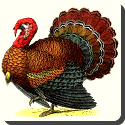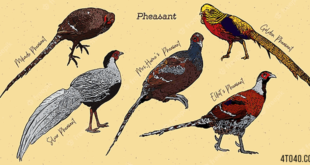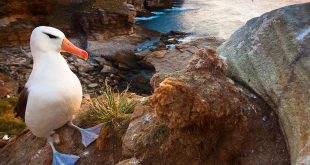 Turkey — A turkey is a large bird in the genus Meleagris, subfamily Meleagridinae, family Phasianidae & order Galliformes. One species, Meleagris gallopavo, commonly known as the Wild Turkey, is native to the forests of North America. The domestic turkey is a descendant of this species. The other living species is Meleagris ocellata or the Ocellated Turkey, native to the forests of the Yucatán Peninsula.
Turkey — A turkey is a large bird in the genus Meleagris, subfamily Meleagridinae, family Phasianidae & order Galliformes. One species, Meleagris gallopavo, commonly known as the Wild Turkey, is native to the forests of North America. The domestic turkey is a descendant of this species. The other living species is Meleagris ocellata or the Ocellated Turkey, native to the forests of the Yucatán Peninsula.
Turkeys are classed in the taxonomic order of Galliformes. Within this order they are relatives of the grouse family or subfamily. Males of both species have a distinctive fleshy wattle or protuberance that hangs from the top of the beak—called a snood in the Wild Turkey and its domestic descendants. They are among the largest birds in their ranges. As in many galliform species, the male (tom or gobbler) is larger and much more colorful than the female (hen).
When Europeans first encountered turkeys on the American continent, they incorrectly identified the birds as a type of guineafowl (Numididae). Guineafowl were also known as turkey fowl (or turkey hen and turkey cock) because they were imported to Central Europe through Turkey. The name turkey fowl, shortened to just the name of the country, stuck as the name of the American bird.
The confusion between these kinds of birds from related, but different, families is also reflected in the scientific name for the turkey genus: meleagris is Greek for guineafowl. Two major reasons why the name ’turkey fowl’ stuck to Meleagris rather than to the Helmeted Guineafowl (Numida meleagris) were the genuine belief that the newly-discovered Americas were in fact a part of Asia, and the tendency during that time to attribute exotic animals and foods to a place that symbolized far-off, exotic lands.
Several other birds, which are sometimes called turkeys, are not particularly closely related: the Australian Brushturkey is a megapode, and the bird sometimes known as the “Australian Turkey” is the Australian Bustard, a gruiform. The bird sometimes called a Water Turkey is the Anhinga (Anhinga rufa), from the shape of its tail when the feathers are fully spread for drying.
Many turkeys have been described from fossils. The Meleagrididae are known from the Early Miocene (c. 23 mya) onwards, with the extinct genera Rhegminornis (Early Miocene of Bell, U.S.) and Proagriocharis (Kimball Late Miocene/Early Pliocene of Lime Creek, U.S.). The former is probably a basal turkey, the other a more contemporary bird not very similar to known turkeys; both were much smaller birds. A turkey fossil not assignable to genus but similar to Meleagris is known from the Late Miocene of Westmoreland County, Virginia. In the modern genus Meleagris, a considerable number of species have been described, as turkey fossils are robust and fairly often found, and turkeys show great variation among individuals. Many of these supposed fossilized species are now considered junior synonyms. One, the well-documented California Turkey Meleagris californica, became extinct recently enough to have been hunted by early human settlers and it is believed its demise was due to the combined pressures of climate change at the end of the last glacial period and hunting.
 Kids Portal For Parents India Kids Network
Kids Portal For Parents India Kids Network





